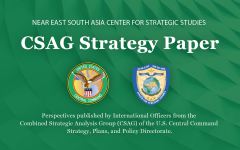The Hardest ‘Soft’ Approach on the Yemeni Crisis: An Opportunity to Retake the Initiative in the Middle East
July 3, 2023 2023-07-03 14:34The Hardest ‘Soft’ Approach on the Yemeni Crisis: An Opportunity to Retake the Initiative in the Middle East
The Hardest ‘Soft’ Approach on the Yemeni Crisis: An Opportunity to Retake the Initiative in the Middle East
CSAG STRATEGY PAPER
By: MAJ Mihai-Florin GIRBOAN, ROU Army (CSAG/CCJ5)
29 June 2023
Overview:
Armed conflicts, across human history, brought unquantifiable loss of fortune, lives, and cultural diversity, effectively stalling, nullifying, or even reversing civilization progress, in countless occasions. This paper aims to clear the “fog of war” that is covering Yemen and the surrounding areas, by presenting the involved actors, their interest in the region, and their current and probable future actions. In addition, it provides a series of recommendations, focused on seizing the opportunities beneficial for both US and the Middle East partners, and leads on processes that might reverse the current trend in the Global Powers Competition, in the light of the new Chinese-brokered Iran-KSA reconciliation.
To effectively deal with conflict, one should always aim to identify the core causes, whether real, perceived or contrived. The real reasons must be addressed and the perceived ones clarified. The contrived must be unequivocally debunked. The struggle will not end until either this is completed or one side completely dominates the other(s). Various degrees of instability will be the result of a mix of imposed “solutions”.
In Yemen’s case, the underlaying reasons of the crisis are not only represented by internal factors. As one of the attributes of being a regional/global power is represented by the ability to project influence over distant countries or entities, this is one of the goals that Iran is seeking to achieve through involvement in the Yemen conflict. Hence, limiting this kind of action is a way to limit Iran’s aspirations to become even more influential in the Middle East, along with denying Iran’s de facto access, basing, and overflight (ABO) in the Southern end of the Arabian Peninsula, which can strongly affect the freedom of movement on strategic Red Sea lines of communication, in case a high intensity confrontation with the Islamic Republic (and not only) will suddenly spark.
Key Points:
- Risks, vulnerabilities, and opportunities: How the US looking away from Yemen’s ongoing conflict will favor China’s ascension in the region.
- Is there a truly viable way to peace? The real challenge for Yemen, as shown by the last few decades of their history, is not how to get peace, but how to make it last.
- While chasing short term goals seems to bring some volatile gains, long term benefits of stabilizing Yemen are invaluable for the US and the world.
- The KSA-Iran deal is the window of opportunity and Yemen the gate through which the US can begin to wrestle back the initiative from the global competitors regarding the Middle East region, in both diplomatic and economic domains.
- Solving the Yemen conflict through the USCENTCOM lens (People, Partners, and Innovation) is beneficial to all three of USCENTCOM’s Lines of Effort across AOR.
- As the world moves forward, due to increased and cheap access to information and technology, the use of military options through sheer force is becoming less efficient, being severely affected by the cultural and psychological make-up of the given target; thus, a paradigm shift in the way the force is applied is deemed necessary.
View other USCENTCOM Combined Strategic Analysis Group (CSAG) papers here.
The opinions and conclusions expressed herein are those of a number of international officers within the Combined Strategic Analysis Group (CSAG) and do not necessarily reflect the views of United States Central Command, not of the nations represented within the CSAG or any other governmental agency.







